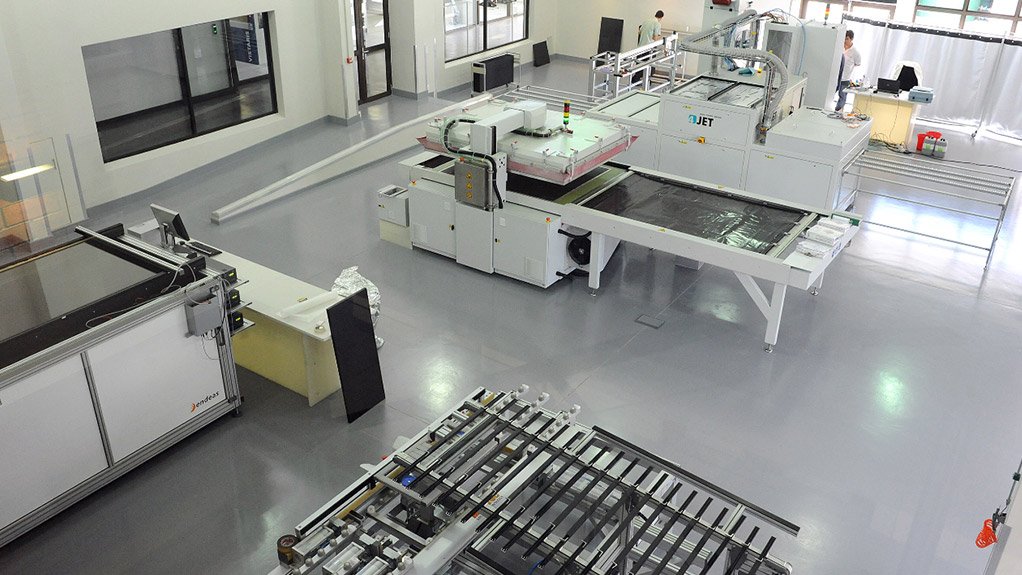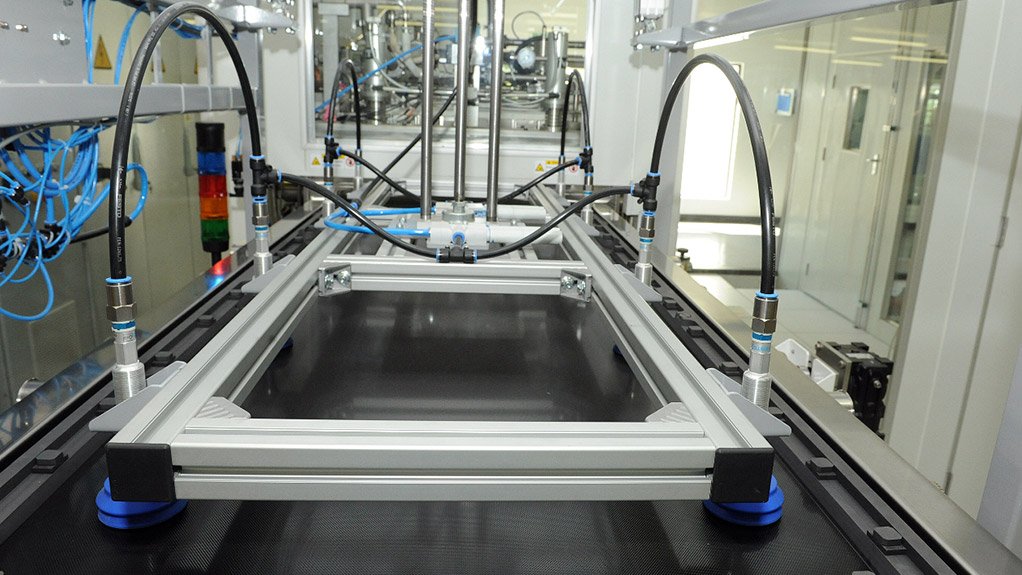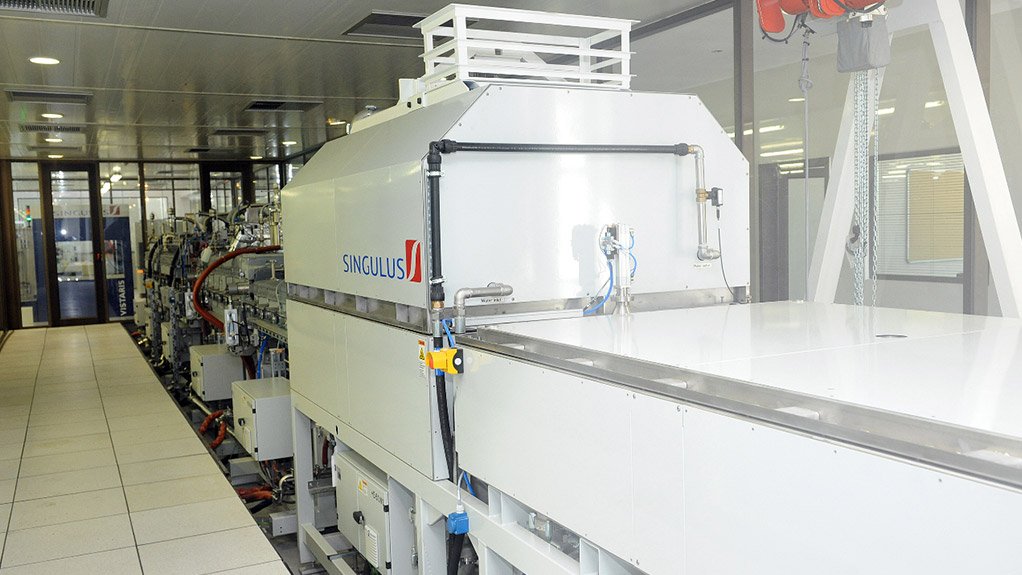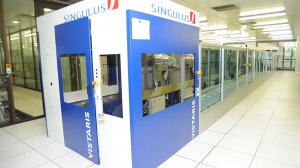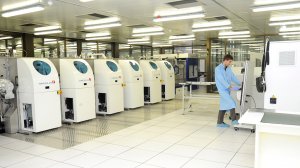A demonstration plant to showcase locally developed thin-film solar module technology, used for converting sunlight into electricity, officially opened its doors on Monday.
The R180-million, 3 500 m2 semi-commercial facility, in Stellenbosch, is a joint venture (JV) between Photovoltaic Technology Intellectual Property (PTiP), a local technology development and intellectual holding company, and Singulus Technologies, a listed German engineering company.
The thin-film technology was developed by the University of Johannesburg’s (UJ’s) Professor Vivian Alberts, now also PTiP CEO.
Alberts’ work at UJ, dating back to 1993, first paved the way for a R12-million pilot plant at the university, with funding provided by the Department of Science and Technology, while the project was also strongly supported by the National Research Foundation.
By 2006, this pilot plant produced semi-commercial products, with the quality internationally and independently verified.
PTiP licensed the thin-film technology internationally in 2007, and today the processes and product characteristics are protected by world-wide patents in 17 countries.
Following licensing, PTiP moved its research laboratories to the Technopark innovation hub, in Stellenbosch, in 2011, where UJ, the Industrial Development Corporation of South Africa (IDC) and the Technology Innovation Agency invested R180-million in the demonstration plant that opened on Monday.
The IDC is a lead shareholder in PTiP and provides expertise and support for the commercialisation of the technology. Alberts and UJ are the company’s founding shareholders.
“Government has supported us for 10, 15 years, and they have been great. We can certainly give them credit for sticking with us, especially over the last three, four years. Now we just need further support to reach full commercialisation,” Alberts told Engineering News Online on the weekend.
He said a combination of government and private investors would be ideal to reach the goal of building a large-scale commercial thin-film solar module plant in South Africa.
“I look at the machines and the people working and it is exactly what my dream was, right from the start,” he added.
“I never suffered the illusion that it would be a quick process to commercialise the technology. It is wonderful to have arrived at this point. I want to do this for the rest of my life. We are 10 to 12 absolutely committed people, with a passion to show that this technology can work, and we spent every day making it even better.”
Alberts’ thin-film module includes an unique homogenous semi-conductor alloy, comprising of five chemical elements.
The thickness of the active materials in the thin-film module is three microns, compared to the traditional first generation silicon technology with a thickness of more than 300 microns.
PTiP converts basic raw materials through about 15 production processes into a fully integrated solar energy product. Depending on the type of glass used at the start, the local content of the panels is between 80% and 90%.
“Photovoltaic (PV) technology is today one of the fastest growing industries in the world and South Africa can now proudly take part in it with a cost effective and advanced second generation, thin-layer PV system,” said Alberts.
He noted that competing thin-film companies include the successful First Solar, and believes that traditional silicon-based panel producers are falling behind financially.
Many silicon-based panels are still imported into South Africa, and then assembled here – “and not manufactured”, emphasised Alberts.
He said his innovation has an edge over silicon-based products because of the innovative semiconductor material that replaces the silicon in the solar panel.
The much thinner material provides the same energy as silicon per square meter.
“However, the investor looks at production cost, and our production cost is around 50% less than that of silicon. We need only three microns to do the energy conversion, and not 300 microns. Silicon is basically a bankrupt technology, which is why there is so much dumping of the product from the East.”
LARGE-SCALE PLANT ON THE CARDS
Alberts said he “would have loved” to have started large-scale commercial production of thin-film modules two years ago, but plans are now afoot for this to happen soon.
PTiP is currently locked in discussions with investors which hope to form a consortium to build a roughly 18 000 m2, 120 MW-a-year local plant. This equates to around a million panels a year.
The investment required for such a plant will typically be more than R1-billion.
“The technology enters an important commercialisation phase over the next 6 to 12 months with the large-scale establishment of production facilities and the roll-out of the technology in South Africa and the rest of the world.
“The aim is to establish a fully fledged local PV industry, to train people and to stimulate job creation in the industry,” said Alberts.
“The demonstration plant will serve as basis for the licensing of PV production facilities worldwide and in Africa. Our JV with Singulus will play a major part in this, with the provision of production equipment and related expertise by the German company.
“In this way a turnkey package, consisting of a building, services, equipment, certified products and the technology can be provided to a client who wants to enter the industry.
“Research has shown that the establishment of a PV plant potentially creates more jobs compared to a coal-driven power plant, with downstream sales, marketing and maintenance services providing an important stimulus,” added Alberts.
The application of the PV panels range from residential houses and buildings, big businesses and independent power producers.
Alberts said investment in a new generation thin-layer PV system can be recouped within three to five years, with a guaranteed life span of 20 years.
EMAIL THIS ARTICLE SAVE THIS ARTICLE
To subscribe email subscriptions@creamermedia.co.za or click here
To advertise email advertising@creamermedia.co.za or click here








